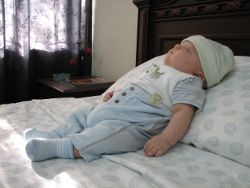Creativity
The Creativity Hack You Can Do in Your Sleep
Here are 5 suggestions for exploiting a creativity loophole.
Posted January 21, 2015

Wanna be a creative genius? I can’t promise that. But I can tell you about a creativity enhancing activity you can try this very day. Creative geniuses from the past swore by it. And it’s so easy, you can do it in your sleep.
It’s called “incubation”. The idea is this: you work on a creative project (like writing, coding, making a video, planning a party, whatever). When you get stuck, you take a break. After setting your project aside for a bit, you get new ideas that seem to come from nowhere.
Many incubation activities will do. Sleeping is one of the best. In fact, you might find that after a good night’s sleep a solution to one of your problems will pop into mind during your morning shower.
Perhaps you already sleep and take breaks. And you already get great ideas in the shower. That’s good. You have some first-hand familiarity with incubation. Still, let’s take a closer look, because you might be able to take better advantage of this marvelous effect.
Here are a few facts and a few suggestions.
Fact 1: Incubation plays a central role in many creativity models.
Long before our modern distinction between the conscious and unconscious minds, people were “visited by muses” and had bouts of “divine inspiration”. Ideas seemed to come out of the blue, as if placed there by a helpful imp or holy spirit.
In 1926 Graham Wallas (a good friend of George Bernard Shaw) published The Art of Thought. Wallas, who had lived a creative life surrounded by other creative folks, proposed that creativity can be broken down into 4 main stages: 1) preparation, 2) incubation, 3) illumination and 4) verification.1
Thirteen years later, James Webb Young, a copywriter, published Technique for Producing Ideas. His 5-stage process included: 1) research, 2) digestion, 3) incubation, 4) inspiration, 5) verification.2
And to this day incubation plays a central role in creativity research..
Fact 2: There’s ample anecdotal evidence that incubation works.
Before Wallas and Young published their models of creativity, Henri Poincaré, who helped lay the mathematical foundations for both special and general relativity, and who is widely regarded as one of the finest minds in history, related this anecdote from his own creative life:
"Just at this time I left Caen, where I was then living, to go on a geologic excursion under the auspices of the school of mines. The changes of travel made me forget my mathematical work. Having reached Coutances, we entered an omnibus to go some place or other. At the moment when I put my foot on the step the idea came to me, without anything in my former thoughts seeming to have paved the way for it, that the transformations I had used to define the Fuchsian functions were identical with those of non-Euclidean geometry.” [emphasis added] 3
Most creative geniuses have similar stories. But legendary mathematicians, physicists, and artists aren’t the only sources of anecdotal evidence. In fact, if you’re anything like me, you sometimes get new ideas for your projects in the shower, while taking walks, while driving, or when drifting off to sleep. Our ideas might not be as revolutionary as those of Poincaré, but they’re just as unexpected and quite often useful.
Fact 3: There is experimental evidence that incubation works.
The evidence for incubation is more than anecdotal. Psychologists have been experimenting with incubation for more than 40 years, and have amassed a good body of experimental evidence for an incubation effect.
The typical experiment goes something like this: subjects are asked to perform a creative task, and their performance on the task is measured. Then some subjects (the control group) keep going for another period of time, and their performance during the second period is measured as well. Other subjects (the experimental group) are given a break (an incubation period), and then resume the creative task after the break. If the experimental group improved more than the control group, this is taken as evidence for an incubation effect.
An oft-used creative task is the “alternative uses” task, in which the experimenter names an object, and the subject then lists as many “uncommon” uses for that object as she can. If the object is “toilet paper”, the subject would ignore the common uses for it, and suggest uncommon uses, such as “making a blanket for a small doll”.
Researchers have tested many different creative tasks (such as the alternative uses task, the remote associates test, the consequences task, visual insight tasks, and linguistic insight tasks), many different incubation activities (rest, light activity, mentally taxing activity, sleep), and different lengths of time for both the initial solving session and the incubation period (ranging from a minute to several days). While some studies fail to show an incubation effect, the majority show one.4
Fact 4: We’re not sure why it works.
How is it that we can work on a project, get stuck, take a break, and then come up with a great new ideas after not working on the project for a while? What happens during that incubation period?
One possibility is that our brains simply benefit from getting some rest. Our brains get tired; we get stuck; we let our brains rejuvenate; we make progress again. We can call this the “Rest Hypothesis”.
Another possibility is that, while we were working on the problem explicitly, our information was limited. When we take a break, we expose ourselves to a new environment, which provides new clues about our problem, leading to new ideas. We can call this the “New Information Hypothesis”.
A third possibility is that we got stuck because we were focused on irrelevant information that was getting in the way of solving the problem. Taking a break allows us to forget about the misleading puzzle pieces so we can start fresh and make more progress. We can call this the “Forgetting False Leads Hypothesis”.
A fourth possibility is that, when we take a break, our unconscious mind keeps working on the problem. Freed from the directions of the conscious mind, it can rapidly activate new memories to bring to bear on the problem. We can call this the “Spreading Activation Hypothesis”.
A fifth possibility is that our unconscious mind, when uninhibited by conscious judging, is free to rapidly try out new combinations of existing ideas to generate new ideas. We can call this the “Rapid Re-Combination Hypothesis”.
A sixth possibility is that time away from the problem will allow our unconscious minds to re-frame the problem, leading to new questions and novel solutions. We can call this the “Re-Framing Hypothesis”.
Researchers have long debated the role of the unconscious mind in incubation. Some creativity theorists suspect that creativity always requires conscious thought, and these theorists tend to make use of only the first three hypotheses. Other creativity theorists think unconscious processing also contributes to the search for new ideas, and they might make use of all six hypotheses.5
Fact 5: Mind-wandering and REM are best.
Which incubation activities work best? This is an important question, because the activities we do on our breaks are within our control. If we choose the right incubation activities, maybe we can boost our creativity.
A survey of research from about 1970 to 2007 suggests that light mental activity (such as light reading, gardening, or going for a walk) produces a stronger incubation effect than either rest or intense mental activity (such as counting backwards by 7s).
Researchers speculate that light mental activity is best because the activity will occupy our conscious mind just enough to keep it away from the project it just got stuck on. This allows the unconscious mind more freedom to work on the problem. With complete relaxation, the conscious mind will try to get involved in the issue again, and might block progress. With more intense mental activites (such as counting backwards by 7s) the unconsious mind gets involved with the new problem instead of the old one we want it to work on.
So the best bet is to engage in an activity, such as walking or light reading, that occupies the conscious mind just enough with an easy problem to let the unconscious do its work on the harder problem.6
When it comes to sleep, it’s REM sleep, the 4th and final stage of each sleep cycle (when dreaming occurs), that produces the best incubation effects.7
Fact 6: Incubation depends on preparation.
Incubation can’t work all by itself. You can’t just go for walks and dream up new breakthroughs in Theoretical Physics without any background in Physics.
In order to get the most benefit from incubation you should expend considerable conscious effort before you take a break. You should get clarity about the problem. You should research the problem. You should explore the problem and solution spaces from many angles and with many questions. Only then will incubation yield its benefits. This is backed by research which shows that the benefits of incubation are correlated with the length of the preparation time. 8
You should also expend considerable conscious effort after the incubation period. Sometimes answers will bubble all the way up to the surface for easy pickings. But sometimes you have to dig around a bit to make all the new connections.
Fact 7: You have to care about getting answers
Another study explored whether a person had to care about getting new ideas during the incubation period. Researchers administered a creativity task, and, after the first period of testing, they told one group of subjects they were done and would not return to that task, they told another group that they would be coming back for a second round, and a third group (the control) kept working. Contrary to what the experimenters claimed, both experimental groups were brought back for a second round of the initial task.
The group that did not expect to return to the task performed no better than the control, even though they had an incubation period. The group that expected to work on the test again performed significantly better after the incubation period. 9
Suggestions:
So there’s reason to think that, if we set our work aside when we get stuck or exhausted, rather than continuing to work on it, we can improve our chances of generating creative insights.
But most of us already do this. No one works on a two-week project straight through without any breaks. We all take time out to sleep, eat and shower. We might even take time out play games or take walks.
We’re already taking advantage of the incubation effect. But maybe, if we are more deliberate about it, we can make a few tweaks to our routine and get even more benefit. With that in mind, here are a few suggestions:
- Distribute your creative work over time. That way you’ll naturally work many incubation periods into your normal schedule. This is one reason experts advise college students to start working on their papers and projects right when they are assigned, even if they aren’t due for two months. Even if they only put 20 minutes per day in brainstorming and researching their papers initially, they should reap substantial benefit from two months of unconscious processing. The student who waits to start a paper until two days before it’s due won’t get this benefit.
- Be more open to taking breaks in general. Plowing through when stuck isn’t as noble as some people think. Consider two students studying for a test. One sits almost motionless poring over notes continuously as she grows increasingly tired. The other blitzes through the material for 20 minutes, and then gets up, gets a drink of water, and wanders around for a couple minutes, then sits and sprints through material for another 20 minutes before getting up to chat with a friend. And so on. The first student looks more diligent, no doubt. But the second is taking advantage of the benefits of mental rejuvenation and incubation. This idea can be difficult to swallow for those raised with a strong work ethic. Sometimes the person who gets the most work done is the one who goofs off a little.
- Find a sport or hobby you enjoy that allows for mind wandering. Knitting, gardening, and pottery are great. But the champion of incubation activities might be walking. And—if it’s creative incubation you’re after—slow, meandering walks in a natural setting are probably better than fitness-enhancing power walks on a health club treadmill. Walking in natural settings not only gives the mind a chance to incubate, it also helps fight depression, gets you some sunshine, improves insulin sensitivity, and on and on. Kant and Einstein were both known for their regular daily walks.
- Prime your mind before you sleep and play. Research shows that your incubation periods will probably be more productive if you remind yourself that you want solutions to your creative sticking points right before you incubate. Try to develop a habit of priming your mind right before you go for walks or fall asleep. You could keep a little notebook beside your bed and write down a question every night before you fall asleep.
- Learn how to ask good questions. Your unconscious creative work will be more productive if your conscious creative work is more productive. And one of the best ways to be more creative consciously is to learn how to ask better questions as you work.. For some advice about asking good questions, I'll recommend the book: A More Beautiful Question by Warren Berger
Bibliography
1 Wallas, Graham, The Art of Thought, 1926 (out of print)
2 Young, James Webb, A Technique for Producing Ideas, 1939. http://www.amazon.com/exec/obidos/ASIN/1434102750
3 Poincare, Henri, The Foundations of Science: Science and Hypothesis, the Value of Science, Science and Method (free kindle edition)
4 Ut Na Sio and Thomas C. Ormerod, “Does Incubation Enhance Problem Solving? A Meta-Analytic Review” Psychological Bulletin 2009, Vol. 135, No. 1, 94 –120
5 Simone M. Ritter* and Ap Dijksterhuis, "Creativity—the unconscious foundations of the incubation period", Hum Neurosci. 2014; 8: 215.
6 Sio and Omerod, p. 107.
7 Cai D. J., Mednick S. A., Harrison E. M., Kanady J. C., Mednick S. C. (2009). “REM, not incubation, improves creativity by priming associative networks.” Proc. Natl. Acad. Sci. U S A 106
8 Sio and Omerod,p. 109.
9 Maarten W. Bos, Ap Dijksterhuis, Rick B. van Baaren, "On the goal-dependency of unconscious thought", Behavioural Science Institute, Radboud University Nijmegen, Montessorilaan 3, 6525 HR Nijmegen, The Netherlands




